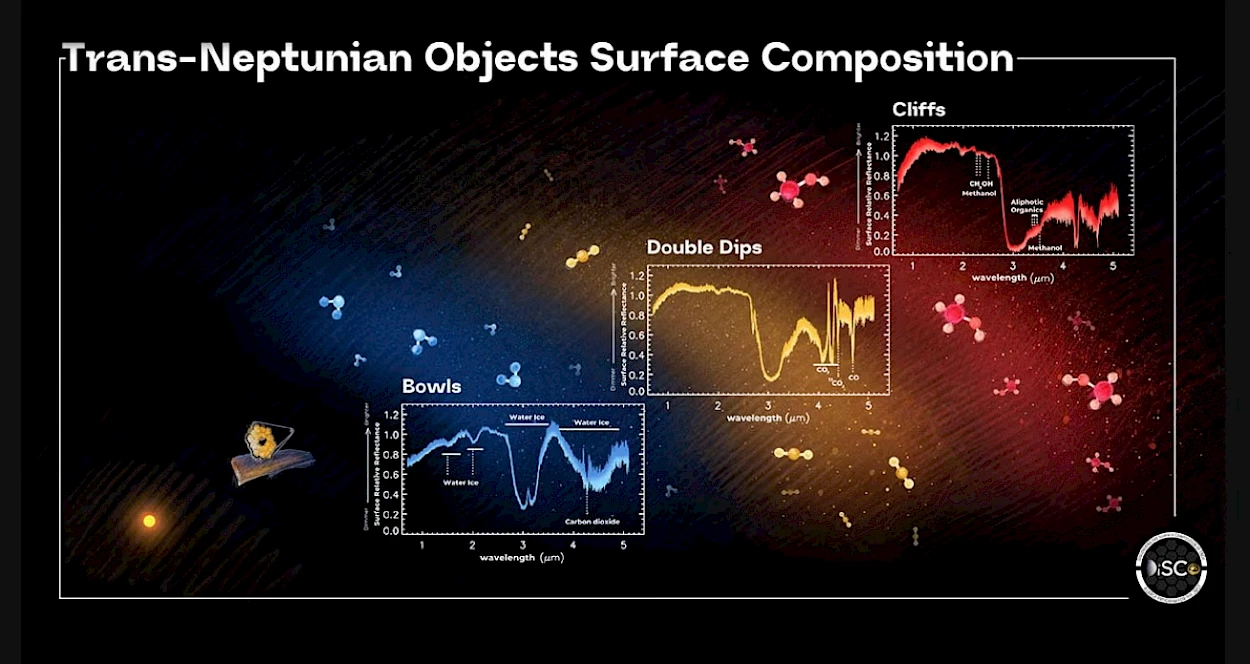James Webb Space Telescope offers unprecedented view of icy planetesimals from the early solar system
Researchers have identified the chemistry, dynamics and origin of some of these bodies and the transformation they undergo as they approach the Sun - vital information for improving models of the formation of our Solar System and other planetary systems.
Using the James Webb Space Telescope (JWST), an international team, including Nuno Peixinho from the Faculty of Sciences and Technology and the Institute of Astrophysics and Space Sciences at the University of Coimbra, observed two regions populated by icy objects: Trans-Neptunian Objects (TNOs) in the Kuiper Belt and Centaurs between Jupiter and Neptune.
In two studies published today in the prestigious journal Nature Astronomy, the researchers identified the chemical composition, dynamics, and origins of these objects, along with the transformations they undergo as they approach the Sun. These findings are crucial for refining models of Solar System formation and understanding other planetary systems.
Nuno Peixinho says, “After over 30 years of studying these icy bodies in the Kuiper Belt—true ‘living fossils’ of our Solar System’s formation—we’ve finally identified water ice, carbon dioxide, methanol, and some organic molecules. The concentrations of these compounds were largely determined by their distance from the Sun during formation, which allows us to start piecing together how these objects mixed throughout the Solar System.”
The JWST enabled astronomers to detect different molecules that make up these icy fossils by observing in the infrared spectrum, which is inaccessible from Earth due to atmospheric interference. Team leader Noemí Pinilla-Alonso, from the University of Central Florida and the Institute of Space Sciences and Technologies of Asturias (ICTEA), noted: "The importance of this discovery is that it shows the current composition of the surfaces of these objects is determined by the materials available in the pre-solar disk during planetesimal formation. It's like a frozen snapshot of the Solar System's infancy."
The project aimed to determine the relative proportions of water, complex organic compounds, silicates, and volatile ices in a large sample of TNOs. This information enhances Solar System formation models and sheds light on the origin of water—and possibly life—on Earth and elsewhere.
Understanding the ice retention lines is crucial to these models. For example, water freezes closer to the Sun, while carbon dioxide and methanol freeze further out. One major is that water ice,- once believed to be the most abundant surface ice, is less common than previously thought. Instead, carbon dioxide (CO2), a gas at Earth’s temperature, and other carbon oxides, such as the highly volatile carbon monoxide (CO), are found in many objects.
Planetary migrations shaped the solar system billions of years ago, dispersing and mixing small ice-rich bodies. Neptune’s gravity continues to influence TNO orbits, occasionally pushing them inward into the region of giant planets between Jupiter and Saturn, where they become centaurs.
Peixinho explained, "We also studied centaurs, which temporarily occupy the orbits between Jupiter and Neptune. Jupiter’s gravity eventually pushes most of them closer to the Sun, transforming them into comets. Before this happens, we've found that they lose much of their original ice, suggesting that this ice gradually disappears before they become active comets.”
The team categorised the TNOs into three distinct groups based on their surface compositions. The groups were nicknamed “Bowl,” “Double-dip,” and “Cliff” due to the shapes of their light absorption patterns.
Peixinho adds, "We've shown that it’s possible to study, almost in real time, the chemical evolution of the surfaces of these objects as they travel from the Kuiper Belt to the inner Solar System.”
Nuno Peixinho was instrumental in the analysis and interpretation of the spectroscopic data, particularly in statistical evaluations and comparisons with previous photometric results. He concludes, “We’ve got a lot more to analyse, and we’ve already submitted further observing proposals to James Webb to get more data and hopefully groundbreaking discoveries. These findings will also help answer the question of what role the many comets that have fallen to Earth in the past played in how life emerged on Earth, a question that many astrobiologists are trying to answer to this day”
The scientific article “A DiSCo JWST portrait of the primordial Solar System through its trans-Neptunian objects” is available here.

